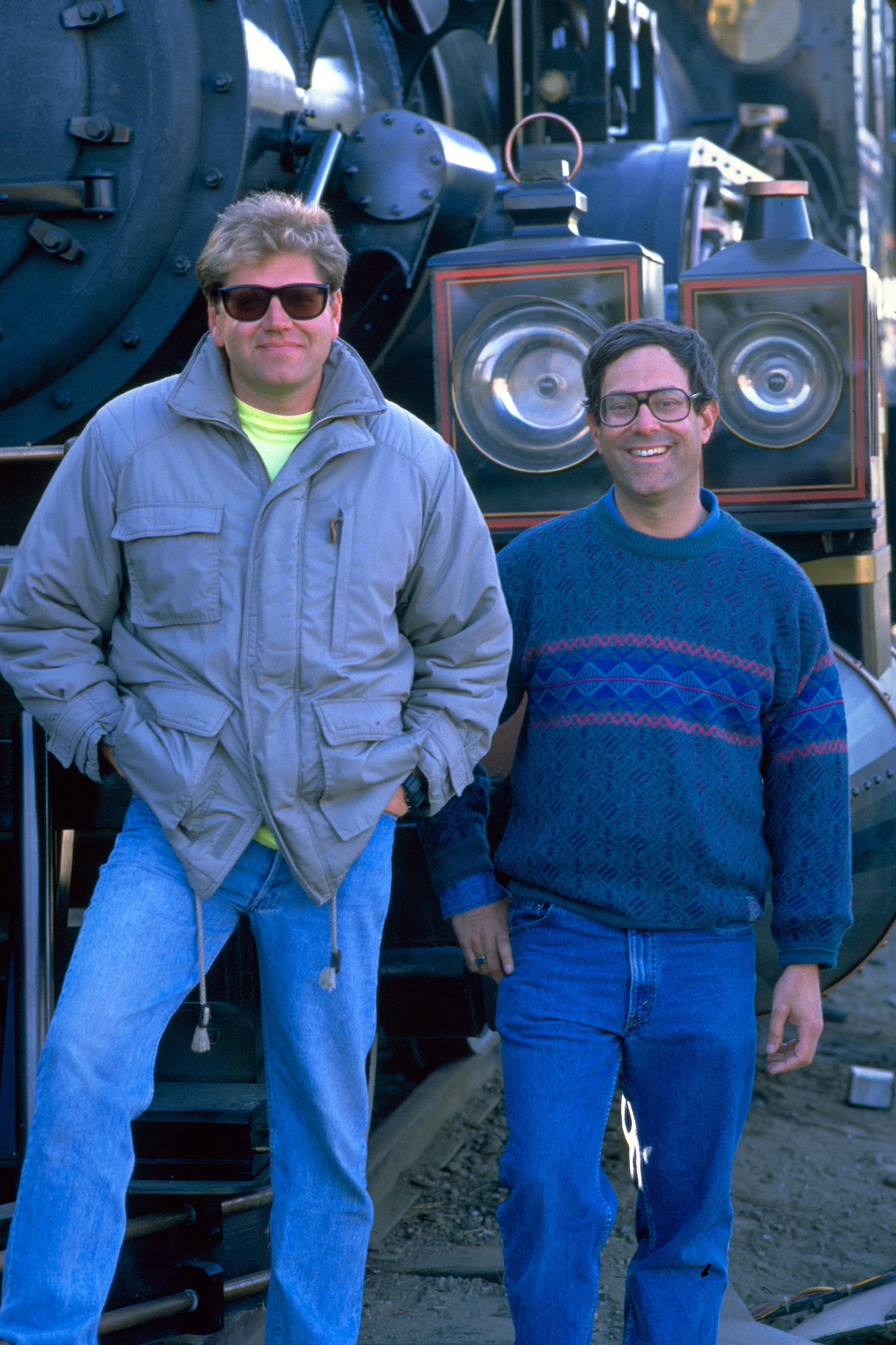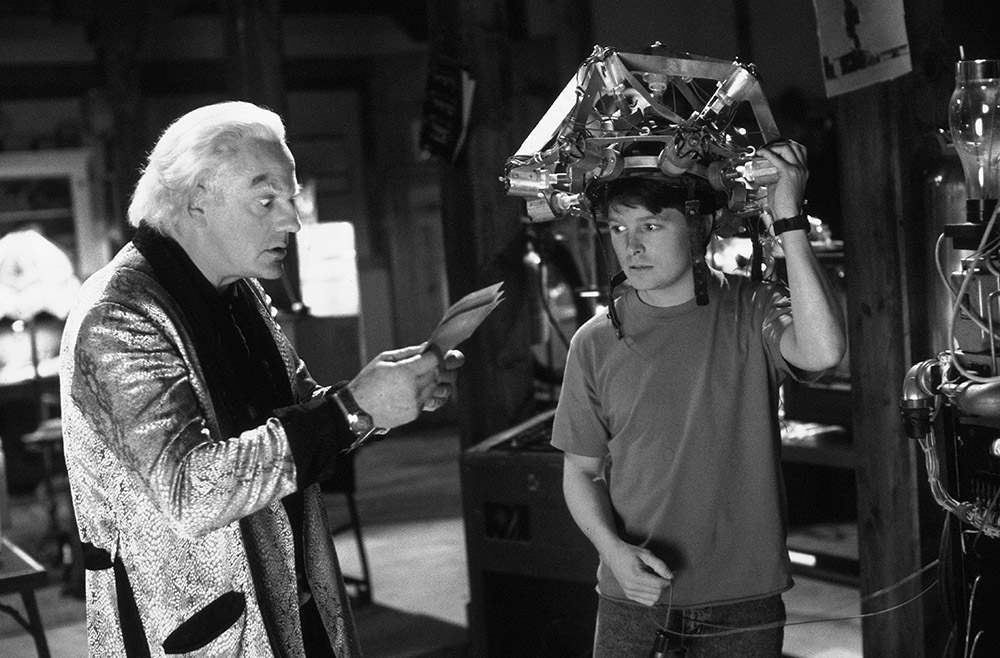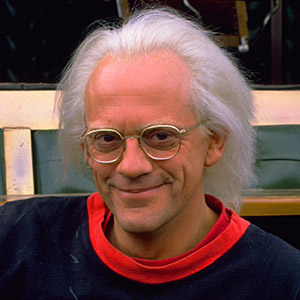
FAQs
The Most Frequently Asked Questions from Back to the Future
by Bob Gale & Robert Zemeckis
We get letters. And phone calls. And we meet fans. And a lot of ‘em have questions. Some of these questions are perceptive, some are naive, and some are, well, pretty dumb. Some are from time travel fanatics who ask for explanations about some of the mysteries of the space-time continuum. Some are from children who want us to send them a hoverboard (Our favorite was from an 8 year old boy: “Please send me a hoverboard, but don’t send me a pink one.”)
Here are some of the most frequently asked questions about all three Back to the Future films — and answers.
Back to the Future — Part I
In the Darth Vader scene, Marty has a modern hair dryer tucked in his belt, obviously not something they had in 1955. Where did this come from?
The hair dryer was in a suitcase that 1985 Doc put into the DeLorean trunk at Twin Pines Mall. There was a scene in which 1955 Doc looks through the contents of that suitcase, picks up the hair dryer and asks "What's this?" "A hair dryer," Marty replies. Doc shakes his head and says, "A hair dryer? Don't they have towels in the future?" However, the scene was cut from the final film (for time).
Back to the Future — Part II
If Griff is Biff's grandson, how come we never meet Biff's son?
Actually, it's never been established whether Biff has a son. Since we don't know what Griff's last name is, Griff could be the son of Biff's daughter.
Are Hoverboards real?
No. Hoverboards do NOT really exist. This is the most asked question we get in letters and phone calls. Yes, Director Robert Zemeckis did give an interview in which he said that hoverboards were real, but his tongue was firmly in cheek. Nevertheless, a lot of people believed it — including some executives at one of the three major television networks! We'll say it again: HOVERBOARDS ARE NOT REAL. But based on our mail, there's a tremendous demand for them, so maybe some enterprising inventor should get to work!
Are Hoverboards real? No, says Bob Gale and Robert Zemeckis, but “maybe some enterprising inventor should get to work,” they say.
Where can I get a pair of those self-lacing shoes that Marty had?
You can't. It's purely a special effect, and those shoes do not really exist. As far as we know, Nike has no current plans to develop such a shoe.
What happened to old Biff when he staggered out of the DeLorean in 2015?
Our intention regarding old Biff was that upon his return to 2015, he would be erased from existence because he had changed his entire destiny by giving his younger self the Sports Almanac. (Probably, Lorraine shot him sometime around 1996!). After old Biff clutches his chest and staggers (the same symptoms that Marty exhibited in Back to the Future when he was beginning to be "erased"), we actually filmed him falling onto the street and vanishing, and we previewed the movie this way. However, the vast majority of the audience did not understand it, so we decided to cut it out, leaving the answer ambiguous, and subject to various interpretations — besides the above explanation, you can believe that Old Biff had a heart attack from the shock of time travel of from flying the car, or from something that happened to him in 1955.
When Doc and Marty are in 1985-A, Doc says they can't return to the future to stop Biff from stealing the DeLorean, because it would be the wrong future. But if that's true, how did Old Biff manage to get back to the same future that he left? Shouldn't he have come back to a different future?
As should be clear from the answer to the previous question, we believe Old Biff DID indeed return to a different future — a "2015-A," which would have transformed around Marty, Doc, Jennifer and Einstein (just as Doc explains how 1985-A would change into 1985 and instantly transform around Jennifer and Einstein). This would happen AFTER Old Biff returned with the DeLorean. For this reason, we made sure that Doc had caught Jennifer and exited the McFly Townhouse before Old Biff returned. Thus, by the time Marty and Doc are carrying Jennifer back to the DeLorean, there COULD be other residents in that townhouse — or perhaps the McFlys still live there. It is just as believable that the physicality of the neighborhood did NOT change as it is to believe that it did — so we didn't change it. We decided not to make anything of this idea because this is one of those difficult time travel concepts that general audiences have a real hard time understanding. (Try explaining this stuff to your mother and you'll see what we mean.) A detailed explanation of it would have slowed down the story, and most of the audience doesn't ever think about it. That's why we made certain things ambiguous and left various things open for interpretation in hopes that the possibility of at least one or two explanations would be better than a "definitive" explanation that you could find holes in. Let's face it, time travel is fantasy, so there's no way to "prove" anything. As filmmakers, we try to create a set of rule for our stories and stick by them, and stay consistent within the little "universe" that we've created.
When Doc and Marty leave 2015 to go back to 1985, the time displays show that the "Last Time Departed" is November 12, 1955, 6:38 PM, which must be the time that Old Biff left 1955. But since he gives himself the Almanac much earlier in the day, what was Old Biff doing for all of that time?
The "extra hours" were designed into the time display for a simple production reason: at the time we filmed the sequence when Doc, Marty and Jennifer leave the future, we still weren't sure whether the scene when Old Biff gave Young Biff the almanac would be day or night. We left room on the time displays so that we'd be covered if the scene took place at night. Our thinking as to what Old Biff might have been doing for those extra hours included two very believable possibilities: 1) Old Biff, having never traveled through time, decided to do a little additional nostalgic sightseeing before returning to the future; 2) Depending on where Old Biff hid the DeLorean, he may have had to wait for it to get dark before he could leave, for example to avoid being spotted by the police who could have shot at him.
Doc says that if Jennifer sees her older self it could create a time paradox that might destroy the universe. Please explain.
First of all, let's define TIME PARADOX. A Time Paradox is a situation in which the effect of an incident contradicts or eliminates the cause of that same incident. As an example, imagine that in 1990, 40 year old John Smith goes back in time 30 years and finds his younger self, aged 10, in 1960. Suppose 40 year old Smith pulled a gun and murdered his 10 year old self. Then 10 year old Smith would never grow up to become the 40 year old Smith. How then could 40 year old Smith go back in time to murder "himself'? Thus, the effect of the incident (the murder of 10 year old Smith) eliminated the cause (the existence of the murderer). A paradox, by definition, is impossible. In the case of Jennifer, the shock of seeing herself old causes her to faint. But what if young Jennifer had hit her head on a cement stair, suffered brain damage and died? Then, she would never grow up to marry Marty, they would never have kids, and Doc would never have had reason to bring them to the future in the first place. And if Jennifer never goes to the future, how can she die in the future? (Also, in Back to the Future, if Marty had actually been erased from existence by never having been born, he would have never existed to grow up, go back in time, and interfere with George being hit by the car!) For the record, many scientists use the time paradox concept as an argument as to why time travel has to be impossible. Since time travel allows possibility of a paradox, and since a paradox is impossible, time travel itself must be impossible. However, in the Back to the Future films, time travel DOES exist. Thus, Doc Brown surmises that if a paradox were indeed to occur, the result could be cataclysm of some sort. On the other hand, since a time paradox never truly does take place in the films, it could mean that there's some sort of "self preservation" mechanism in the cosmos which prevents a paradox from ever happening. Perhaps then, this is the reason that both Jennifers faint — to prevent a potential paradox!
When Doc takes Marty and Jennifer out of 1985 and brings them to the future, how can Old Marty and Old Jennifer (and their family) even be in the future? Wouldn't their disappearance from 1985 instantaneously erase their future?
To be honest, yes, it very well should erase their existence from the future. This is, in fact, the ultimate paradox of Back to the Future Part II. We really thought about this one for a long time, but we finally decided that after the set-up of Doc saying "Something's got to be done about your kids," the audience would feel cheated if we went to the future and found out they didn't exist. You could, however, argue that existence of Old Marty, Old Jennifer and their kids in the future automatically proves that young Marty and Jennifer will eventually get back to 1985. The flaw in this reasoning is that Doc repeatedly tells us that the future isn't written, so why would this part of the future be "written?" Ah, but Back to the Future Part III may contain the answer to this question after all. When Doc spots the tombstone in 1885 and sees that the name on the photograph of the tombstone has vanished but the date remains, he says "We know this photograph represents what will happen if the events of today continue to run their course into tomorrow." That's a pretty big "if." And it suggests that time travel to the future always takes you to a future based on the events of the time you left — a logical extrapolation of what the future of that moment holds. Of course, the existence of free will allows for the possibility of infinite futures, which is what Doc says at the end of Back to the Future Part III: "Your future is whatever you make it." But time travel into the future takes you to the most likely future of the moment you left.
Why is it that Jennifer faints when she sees her future self, but Biff has no problem when he meets his older self?
Jennifer definitely realizes she is seeing herself 30 years older and that puts her into shock. Young Biff, however, has no idea who old Biff really is — he thinks it's just "some old codger with a cane."
What is the significance of the pair of "backwards 9's" of fire left behind when the DeLorean is struck by lightning?
When the big bolt of lightning hits the DeLorean, it sends the flying vehicle spinning on its axis. As we already know, the DeLorean leaves fire trails behind it when it travels through time. Since in this case, the car was spinning, the fire trails are left behind as spirals instead of the usual straight lines left behind when the car is moving straight ahead.
How could the DeLorean travel through time when it gets struck by lightning if it isn't going 88 miles per hour?
The sudden rotation of the DeLorean from the lightning hit accelerates it to 88 miles per hour when it spins.
Why does Maggie McFly look so much like Marty’s mom, Lorraine? According to Bob Gale, “when Seamus married Maggie, that insured that the McFly men would have a genetic trait that attracted them to women who bear a resemblance to Maggie.”
Back to the Future — Part III
Lea Thompson plays Maggie McFly, Marty's great-great-grandmother, as well as Lorraine, Marty's mom. But Lorraine's family name is "Baines". Why did Lea play Marty's paternal great-great-grandmother, when she's really not part of that family? Is there something kinky going on in the history of the McFly family?
Lea plays Maggie because we didn't want to make a Back to the Future Part III without having Lea in it, especially in a "Mom is that you" scene! Of course, we thought about whether it made any sense — obviously, Maggie McFly and Lorraine Baines cannot be blood relatives. But we did come up with a satisfactory answer: It's a well known adage that "men are attracted to women who remind them of their mothers." Clearly then, when Seamus married Maggie, that insured that the McFly men would have a genetic trait that attracted them to women who bear a resemblance to Maggie or Lea Thompson (even Jennifer is the same physical type!)
How could Clara have erected the tombstone for Doc after September 7, 1885 if she was supposed to have gone over the cliff on September 4th? At the beginning of Back to the Future Part III, would the name of the ravine be "Clayton," "Shonash" or "Eastwood?"
Version #1 — "Original History"
The "Original History" occurred before Doc Brown was ever born or invented the time machine. This is how things would have been written in the history books in Back to the Future, and in most of Back to the Future Part II.
August 29, 1885: Hill Valley Town Meeting. No one volunteers to meet the new school teacher at the station.
September 4, 1885: Clara arrives at the train station. Since no one is there to meet her, she rents a buckboard. While heading out to the school house, a snake spooks the horses, they run wild, the buckboard goes out of control, and over the edge of Shonash Ravine. Clara is killed.
September 9, 1885: After a memorial service for Clara Clayton, the city fathers decide to name the ravine in her memory. Thus, "Shonash Ravine" becomes "Clayton Ravine."
Again, Version #1 is the history of Hill Valley that happened BEFORE the beginning of Back to the Future.
At the conclusion of Back to the Future Part II, Doc is zapped back to January 1, 1885. He settles in Hill Valley as a blacksmith, and the above events are altered because of his presence, as follows:
Version #2 — Doc in 1885, without Marty.
August 29, 1885: Hill Valley Town Meeting. Doc Brown volunteers to meet the school teacher at the train station.
September 4, 1885: Doc meets Clara at the train station and they fall in love at first sight.
September 5, 1885: Doc takes Clara to the festival. Buford shows up and shoots Doc in the back with the derringer. Despite Clara's efforts at nursing him, Doc dies two days later from internal bleeding as a result of the gunshot wound.
September 9, 1885: Clara dedicates Doc's tombstone, "In loving memory from his beloved Clara."
In this sequence, the name of the ravine remains "Shonash Ravine." This history ripples into the future AFTER Doc is struck by lightning at the end of Back to the Future Part II. Marty, however, retains his knowledge and memory of the original history because he has come from a point in the space-time continuum in which the original history applied. If Marty were to go to the ravine in 1955 at the beginning of Back to the Future Part III (on his way to the Pohatchee Drive-In, for example), he would discover that the ravine is called "Shonash Ravine."
In Back to the Future Part III, Marty's trip to September 2, 1885 alters Version #2 as follows:
Version #3 — Doc and Marty both in 1885
August 29, 1885: Exactly the same as in version #2: Doc volunteers to meet the school teacher.
September 3, 1885: As seen in Back to the Future Part III, Marty shows Doc the photo of the Tombstone. Doc decides NOT to meet Clara at the station.
September 4, 1885: Clara arrives at the station. No one is there to meet her, so she rents a buckboard, as in Version #1. Similarly, on her journey to the schoolhouse, the snake spooks the horses and they run wild toward the ravine. As seen in the film, Doc rescues her from going over into the ravine. They meet and fall in love at first sight.
September 5, 1885: At the festival, Doc's behavior is now different due to his knowledge that Buford is going to shoot him in the back (which is why Doc keeps facing front to Buford). Because Buford never does shoot him at the festival, and due to Marty's interference, the name on the tombstone photo vanishes.
September 7, 1885: "Clint Eastwood" is apparently killed when the runaway locomotive plunges into the ravine. In honor of his heroic action against Buford Tannen, the city fathers decide to name the ravine after him.
(Incidentally, there is an alternative scenario that may have occurred in Version #2: On September 15, 1885, Clara, distraught over Doc's death, commits suicide by jumping into the ravine. As a gesture of sympathy, the people of Hill Valley decide to name the ravine in her in memory, thus putting the space-time continuum back into a similar situation as in Version #1. We will remain ambiguous about whether this suicide incident actually happened in Version #2 so that the viewer may choose whichever scenario fits into his own theories about time travel.)
Doc Brown of 1955 learns a lot about the future from Marty. Shouldn't the Doc of 1985 remember all of those things that happened in 1955?
3 possible answers, all credible.
1) The "Ripple Effect" of time travel (which caused all of the photographs to change) does not affect human memory.
2) The 1955 Doc suffered a memory loss sometime after his adventures with Marty (maybe it was from the drugs he took in the 60's as Reverend Jim!).
3) Doc actually did remember everything, but he still did all the same things he "remembered" because he didn't want to risk disrupting the space-time continuum.
There's a 4th possibility which depends on your view of time travel. There's a theory (we like to call it the "Self-Preservation Instinct of the Space-Time Continuum Theory") that says that the continuum is always trying to keep itself "on course," and when things happen to change it, it always tries to correct itself. It is much like a river, which tries to keep its overall course. Although earthquakes, fallen trees, floods, or other circumstances might disrupt it at points, the river would cut a new channel so that it would end up back at the same place. Thus, the overall physics (or metaphysics) of the space-time continuum would insure that any of Doc's memories of events that might create paradoxes would become hazy — or be erased.
In I885, when Marry tells Doc they're out of gas; why don't they just go to the Delgado Mine, dig up the DeLorean where Doc hid it and get the gas out of it?
There are two logical answers to this one...
1) The car mechanic's answer: As anyone who has stored an automobile for a long period of time can tell you, you always drain all of the fluids out of the car before putting it into storage. Doc most certainly would have drained the gas out of the DeLorean if he was going to leave it hidden for 70 years. At the 1955 drive-in, Doc specifically says "I put gas in the tank", indicating that the DMC must have had an empty tank when they found it in the mine.
2) The time travel theory answer: Even if Doc had not drained the tank, he still would not have gone back into the mine for fear of creating a time paradox by accidentally damaging the DeLorean, the mine, or who knows what. After all, since Marty is now back in 1885, Doc's plan obviously worked, and worked perfectly. But what if Doc were to go back into the mine and accidentally cause a cave-in that causes even more damage to the DeLorean? What happens to the future of that DeLorean, when it's unearthed in 1955? And what might that do to Marty and the undamaged future DeLorean now in 1885? As an analogy, imagine a time traveler going back in time, finding himself as a child, and cutting off that child's hand with a meat cleaver. What happens to the adult time-traveler's hand? That would definitely risk a time paradox, and we know that Doc would never go out of his way to risk such a thing for fear of (in the worst case scenario) unraveling the fabric of the space-time continuum and destroying the entire universe.
Doc and Marty have many questions about the past and future. Fortunately, Bob Gale and Bob Zemeckis gave them both bright futures.
In Back to the Future Part III, Doc smirks when he learns that his future dog is named Einstein. Yet in Back to the Future, Marty videotapes Doc's time travel experiment with Einstein, and the 1955 Doc watches the tape.
Since Doc's reaction to Einstein in Back to the Future Part III indicates he did not know about the dog, we can only assume that Doc never watched that portion of the tape — or didn't pay much attention to it.
General Questions
What are some of the details to look for on repeated viewings?
As fans of the films know, all three films contain lots of details, some of which are not evident until you see the movie more than once. Here are only a few things you may not have noticed:
In Back to the Future Part II, very difficult to read, is a sign in front of the Biff Tannen Museum that says "Smoking Required."
In Back to the Future Part III, Doc's bandanna is made out of the shirt he was wearing in Back to the Future Part II when he got sent back to 1885.
In 1885, "Honest" Joe Statler, deals in buying, selling and trading of horses in Hill Valley. In Back to the Future, the name of the Toyota dealership is Statler Toyota. (And in 1955, the Studebaker dealer is Statler Motors, which can be seen on a billboard at the Drive-In in Back to the Future Part III.) Obviously, the Statler family has been in the transportation business for a long time!
In Back to the Future Part III, at the Drive-In, the three films playing, listed on the marquee, are all sequels and all Universal films.
In Back to the Future Part III, when Marty and Doc are at the train station looking at the map of Shonash Ravine, Clara is standing in the background, with her back to us, waiting for someone to pick her up.
Is there going to be a BACK TO THE FUTURE — PART IV?
We have no plans or desires to make a Back to the Future Part IV. We think we've taken Doc and Marty through an odyssey that's rounded them both out as complete characters and which also suggests they'll both have fine futures; we've developed and executed almost every time travel idea that's ever interested us, and we feel that another Back to the Future would only get stale and hackneyed. After five years, the filmmakers and the cast are all ready to try other things, and we prefer to end the series on a high note!















